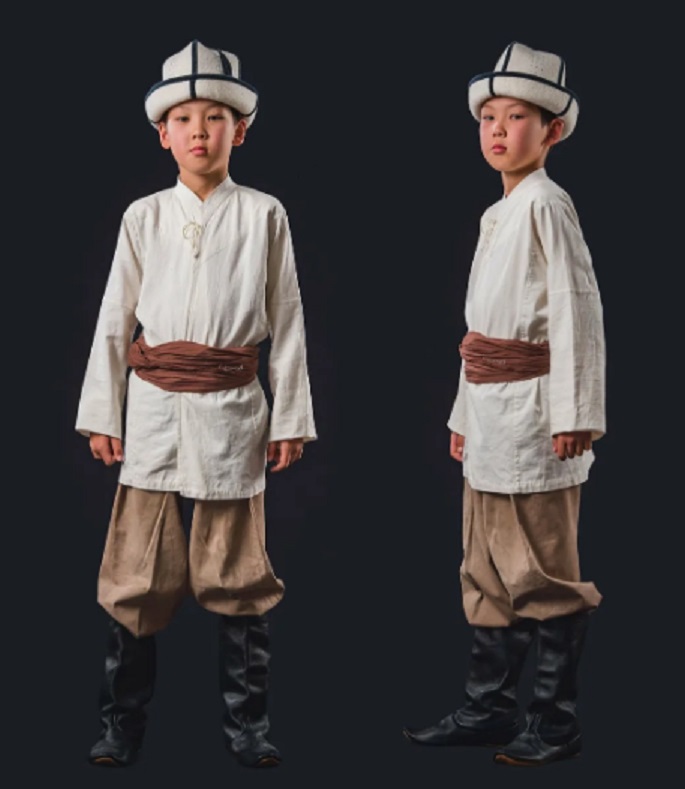
Headwear
Headwear was an essential part of the national male costume. They were characterized by a great variety of types. Men's winter hats called tebetey were widely used, with the crown made from four felt wedges covered with cloth, velvet, or dense fabric. The shape of the wedges determined the shape of the crown - either high and quadrangular or flattened. Traditionally, tebetey had a trim made of merlushka, fox, or another type of valued fur. This hat was named according to the type of fur trim: kerpё tebetey, tulku tebetey, kunduz tebetey, etc.
In the southeastern regions where the Kyrgyz settled, winter hats made of sheepskin called kashgar tebetey were worn. Their quilted crown consisted of four high wedges covered with cloth. A decorative feature of the kashgar tebetey was a strip of fabric sewn parallel to the fur trim, 4-5 cm wide, often in two contrasting colors.
The sheepskin hat telpek was sporadically found in the south, with a crown made of 4-6 high triangular wedges, unlined, and with a narrow fur trim. Sometimes the telpek was covered with dark fabric.
An ancient male headwear is the white felt hat called kalpak, which still exists today in various styles and decorative designs. The most common types are the kalpak with a low crown without cuts and the kalpak with a high crown and two cuts. The brim of the second variant is trimmed with dark fabric, usually black velvet, on which zoomorphic figures or plant shoots are embroidered.
The top of the ancient kalpaks was decorated with a tassel bulbul chechme (“nightingale knot”), framed in a silver decorative clasp. Based on the crown's design, three types of kalpak can be distinguished: seamless, made of two or four wedges. Kalpaks with a seamless crown went out of use in the first quarter of the 20th century.
Along with the kalpak, the traditional male costume included a fur hat - tumak, similar to the Kazakh tymak. In the past, during winter military campaigns, it was worn over the helmet tuulga (Kochkunov, 2008, pp. 41-52).

Under the upper headwear, elderly men wore a topi cap, which they removed at home, leaving only the topi on. An ancient form of it was the burmv topi, sewn from a slightly oval base and a slightly slanted wide band. It was made from white fabric without lining, uniquely decorated with gathers: the fabric was gathered in such a way that a ripple formed on the surface of the entire topi. For older men, white topis were made and embroidered along the band with black and red threads in a cross stitch.
A quilted topi was also common. It was made from four high wedges on a lining and quilted along the wedges and across the band. The frequent stitching method created a ribbed surface.
The belt was an obligatory element of the male costume. They were belted with a sash boto kur, bel kur, belboo or a wide velvet belt or scarf. When choosing the color of the sash, the man's age was considered. Thus, older men preferred a white sash, while younger men chose red. Boys began to wear a sash along with a button-up shirt. Over time, homemade sashes were replaced by factory-made ones. In Southern Kyrgyzstan and Pamir, silk or cotton waist sashes charchy, oromol were traditionally used, influenced by the neighboring Uzbek and Tajik populations. Often, they were belted with both a sash and a scarf or with a scarf and a leather belt.
Wide leather kemer, bodёnё kemer decorated with silver ornamental fittings were also common.
They were worn only over outer clothing on festive occasions. Narrow belts with silver decorations were also popular. Daily wear included leather belts with pendants: knives in sheaths, leather cases for razors, awls, flints, and other personal items were attached to the straps; the cases were decorated with embossing and silver fittings.
Men's clothing of the Kyrgyz in the late 19th - early 20th century.













































